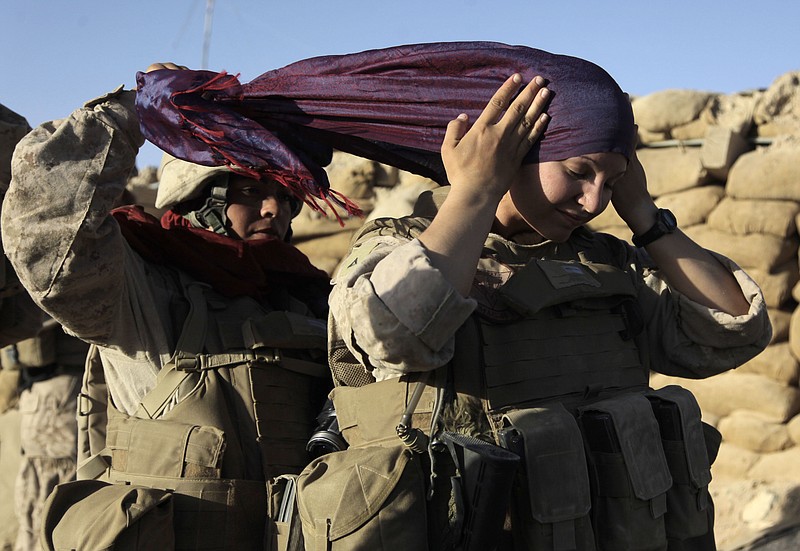WASHINGTON (AP) - New orders from the Pentagon: The military on Thursday formally opened thousands of jobs to women in units that are closer to the front lines than ever before, reflecting what's already been going on as female American soldiers fight and die next to their male comrades.
The new rules, affecting thousands of jobs, will break down more of the official barriers that have restricted the military positions women can take. They're being sent to Congress, and if lawmakers take no action after 30 work days the policy will take effect.
The changes still aren't coming fast enough for some in Congress or the military. They noted the rules still ban women from serving as infantry, armor and special operations forces, which are considered the most dangerous combat jobs.
Instead, they reflect what's been happening for the past 10 years of war in Iraq and Afghanistan. They will allow women to perform many of the jobs they are already doing - but in smaller units, closer to the fighting and once considered too dangerous.
"Unfortunately, the conclusions of this report do not go far enough," said Rep. Loretta Sanchez, a member of the House Armed Services Committee who started a caucus on women in the military. Sanchez said she was "very disappointed" the Defense Department didn't lift the ban on combat jobs for women.
Because service in combat gives troops an advantage for promotions and job opportunities, it has been more difficult for women to move to the higher ranks.
A 1994 Pentagon policy bans women from being assigned to ground combat units below the brigade level. A brigade is roughly 3,500 troops split into several battalions of about 800 soldiers each. Historically, brigades were based farther from the front lines and they often include top command and support staff, while battalions - now open to women - are usually in closer contact with the enemy.
In the past decade, the necessities of war propelled women into jobs such as medics, military police and intelligence officers, and they were sometimes attached - but not formally assigned - to battalions. So while a woman couldn't be assigned as an infantryman in a battalion going out on patrol, she could fly the helicopter supporting the unit, or move in to provide medical aid if troops were injured.
The new rules will formally allow women to work in those jobs at the battalion level. And they will also open up a number of Army jobs that had been closed to women, such as tank and artillery mechanics or rocket launcher crew members.
While the rules won't open up the Navy SEALs or the Army Delta Force to women, some defense officials have said the military may eventually be open to that. Former Defense Secretary Robert Gates told North Carolina ROTC students in 2010 that at some point there would be careful steps in that direction.
Already, however, women are serving with special operations forces in support jobs such as intelligence analysts, legal specialists, builders and administration assistants.
Vee Penrod, the deputy assistant undersecretary of defense for military personnel, said officials will continue to look for other possible changes, but this was a good start.
"We're at war, a lot of things going on, and it may appear too slow to some, but I see this as a great step forward," said Penrod, who served in the Air Force for 35 years and recalled at one point women weren't allow to be stationed at Minot Air Force Base in North Dakota because "it was too cold."
The numbers, however, underscore how far they have to go. There are currently more than 250,000 positions across the military that are closed to women, and the latest changes will open up about 14,000 of them.
Nearly all are in the Army, mainly due to its size as the largest service and the fact it bans women from infantry or ground combat jobs. The new rules open just 371 jobs in the Marine Corps and 60 in the Navy.
Efforts to expand jobs for women in the Navy are complicated because of privacy considerations, particularly on smaller ships where living quarters are shared by large numbers of sailors.
Though numbers vary by service branch, women make up more than 14 percent of the nation's armed forces - that's roughly 200,000 women in the active duty force of 1.43 million. There long has been opposition to putting them in combat, based on questions of whether women have the necessary strength and stamina, or whether their presence might hurt unit cohesion. There also have been suggestions the American public would not tolerate large numbers of women being killed in war.
But the wars in Iraq and Afghanistan, where battlefield lines are scattered and blurred, and insurgents can be around every corner, have made it almost impossible to keep women clear of combat. Some 280,000 women have been sent to Iraq, Afghanistan or to jobs in neighboring nations in support of the wars, roughly 12 percent of all those who have served there. Of the more than 6,300 who have been killed, 144 were women.

